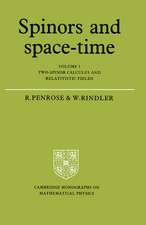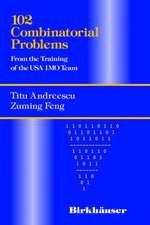Elementary Number Theory
Autor James S. Kraft, Lawrence C. Washingtonen Limba Engleză Hardback – 24 noi 2014
The first chapter of the book explains how to do proofs and includes a brief discussion of lemmas, propositions, theorems, and corollaries. The core of the text covers linear Diophantine equations; unique factorization; congruences; Fermat’s, Euler’s, and Wilson’s theorems; order and primitive roots; and quadratic reciprocity. The authors also discuss numerous cryptographic topics, such as RSA and discrete logarithms, along with recent developments.
The book offers many pedagogical features. The "check your understanding" problems scattered throughout the chapters assess whether students have learned essential information. At the end of every chapter, exercises reinforce an understanding of the material. Other exercises introduce new and interesting ideas while computer exercises reflect the kinds of explorations that number theorists often carry out in their research.
| Toate formatele și edițiile | Preț | Express |
|---|---|---|
| Paperback (1) | 347.17 lei 6-8 săpt. | |
| CRC Press – 14 oct 2024 | 347.17 lei 6-8 săpt. | |
| Hardback (1) | 494.17 lei 6-8 săpt. | |
| CRC Press – 24 noi 2014 | 494.17 lei 6-8 săpt. |
Preț: 494.17 lei
Preț vechi: 655.47 lei
-25% Nou
Puncte Express: 741
Preț estimativ în valută:
94.59€ • 102.78$ • 79.51£
94.59€ • 102.78$ • 79.51£
Carte tipărită la comandă
Livrare economică 21 aprilie-05 mai
Preluare comenzi: 021 569.72.76
Specificații
ISBN-13: 9781498702683
ISBN-10: 1498702686
Pagini: 412
Ilustrații: 9 black & white illustrations
Dimensiuni: 156 x 234 x 25 mm
Greutate: 0.92 kg
Ediția:1
Editura: CRC Press
Colecția Chapman and Hall/CRC
ISBN-10: 1498702686
Pagini: 412
Ilustrații: 9 black & white illustrations
Dimensiuni: 156 x 234 x 25 mm
Greutate: 0.92 kg
Ediția:1
Editura: CRC Press
Colecția Chapman and Hall/CRC
Public țintă
PostgraduateCuprins
Introduction. Divisibility. Linear Diophantine Equations. Unique Factorization. Applications of Unique Factorization. Congruences. Fermat, Euler, Wilson. Cryptographic Applications. Order and Primitive Roots. More Cryptographic Applications. Quadratic Reciprocity. Primality and Factorization. Sums of Squares. Arithmetic Functions. Continued Fractions. Recent Developments. Appendices. Index.
Notă biografică
James S. Kraft teaches mathematics at the Gilman School. He has previously taught at the University of Rochester, St. Mary’s College of California, and Ithaca College. He has also worked in communications security. Dr. Kraft has published several research papers in algebraic number theory. He received his Ph.D. from the University of Maryland.
Lawrence C. Washington is a professor of mathematics and Distinguished Scholar-Teacher at the University of Maryland. Dr. Washington has published extensively in number theory, including books on cryptography (with Wade Trappe), cyclotomic fields, and elliptic curves. He received his Ph.D. from Princeton University.
Lawrence C. Washington is a professor of mathematics and Distinguished Scholar-Teacher at the University of Maryland. Dr. Washington has published extensively in number theory, including books on cryptography (with Wade Trappe), cyclotomic fields, and elliptic curves. He received his Ph.D. from Princeton University.
Recenzii
"This is a nice introduction to elementary number theory, designed for use in a basic undergraduate course. It can be used also for advanced high school students taking an accessible approach for an independent study. The book underlines the role of number theory in pure mathematics and its applications to cryptography and other areas."
—Zentralblatt MATH 1322
—Zentralblatt MATH 1322
Descriere
This text teaches students about the role of number theory in pure mathematics and its important applications to cryptography and other areas. Designed for a one-semester undergraduate course in number theory, the book offers many pedagogical features. "Check your understanding" problems assess whether students have learned essential information. At the end of every chapter, exercises reinforce an understanding of the material. Other exercises introduce new and interesting ideas while computer exercises reflect the kinds of explorations that number theorists often carry out in their research.















